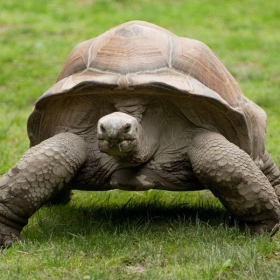
Aldabra Tortoise
Dipsochelys dussumieri
Animal Behavior: Aldabra giant tortoises are active mainly over a period of less than four hours in the early morning and late evening. Aldabra giant tortoises engage in various activities including mating attempts, stretching, walking, feeding, sleeping, and defecation during these times. They rest for the remainder of the day. While resting, they lie with the plastron (the ventral part of the shell) on the ground, with the limbs and head slightly retracted. Large males walk with the carapace high above the ground and the limbs fully extended vertically. Aldabra giant tortoises are found both individually and in aggregate herds in areas with plenty of food. When threatened, Aldabra giant tortoises will quickly withdraw their heads and walk away. Tortoises will fully extend their necks while browsing and occasionally rear up against trees. Aldabra giant tortoises have been known to move seasonally between habitats. During dry seasons, tortoises are dispersed evenly throughout the various habitats. When the first rain occurs, tortoises migrate towards the open grasslands and coastal scrub areas.
Eating Habits: Aldabra giant tortoises are primarily herbivores and feed mainly on vegetation such as grasses, leaves, woody plant stems, a variety of herbs. They are flexible and opportunistic and will sometimes supplement their diets with small invertebrates or carrion, even carrion of its own species. In captivity, Aldabra giant tortoises have been known to enjoy fruits, such as apples, pears, tomatoes and bananas, carrots, peas, beans, almonds, and compressed vegetable pellets. Little fresh water is available in their natural habitat and they must obtain most of their water from food sources.
Range: Aldabra giant tortoises are terrestrial and occur in a wide variety of habitats, including scrub forests, mangrove swamps, and coastal dunes and beaches, each with their respective vegetation. The largest populations of tortoises are found on grasslands called "plains." Due to prolonged periods of heavy grazing, a habitat known as "tortoise turf", consisting of a variety of grasses, has developed in certain areas.
Conservation Efforts: Aldabra giant tortoises are one of the few surviving species of Indian Ocean giant tortoises. They are considered vulnerable due to years of human poaching and encroachment. Translocation of these tortoises has been unsuccessful, partly due to inadequate attention to human-related habitat interactions. Human poaching has significantly jeopardized chances of establishing populations that will survive far into the future.
Animal Facts: Aldabra giant tortoises are the largest living terrestrial species of tortoise (Testudinidae). They are dark gray to black in color and have a high, thick, domed carapace, a very long neck (to aid in branch feeding), and short, thick legs. The limbs and head are covered in bony scales. Mature males have an average carapace length of 120 cm and can weigh up to 250 kg. They have longer and lower carapaces which widen near the rear and longer, thicker tails. Females are smaller than males, with an average carapace length of 90 cm and weight of 160 kg.
